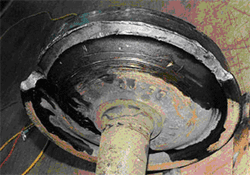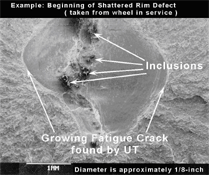

Introduction: This project, sponsored by Transportation Technology Center, Inc (TTCI), develops a methodology to analyze and simulate railroad wheel failure. Several important factors affecting the failure behavior of railroad wheels will be investigated in detail, such as structural details (e.g., rim thickness and wheel design), initial material defects (e.g., internal voids and non metallic inclusions), manufacturing process (e.g., forging vs. casting), failure modes (e.g., wear vs. fatigue) etc.
Methodology: The objective of this project is to combine structural failure analysis, finite element methods, and fracture mechanics to develop a methodology to analyze and simulate railroad wheel failure. This project consists of four tasks; (1) Investigation of the effects of rim thickness and wheel design on railroad wheel failure behavior using numerical modeling, (2) Investigation of the effects of internal voids and inclusions on railroad wheel failure behavior using numerical modeling, (3) Investigation of the effects of residual stress on railroad wheel failure using numerical modeling, (4) Development of a general methodology for railroad wheel failure analysis considering both fatigue and wear mechanisms, and analysis of coupling effects. Task 1: Finite element model of different wheel design parameters (e.g., rim thickness and plate design) will be build corresponding to the realistic field measurements. Parametric studies will be performed using the finite element results to investigate their effects on railroad wheel failures. Task 2: Scanning Electron Microscope (SEM) will be used to obtain initial defect profiles. Image analysis will be used to process the experimental observations and to get initial defect size, shape and distribution. Parametric studies will be performed to study the relationship between defects and wheel performance. Task 3: Manufacturing and service induced residual stresses at wheel tread will be simulated numerically using finite element analysis. The results will be used for fatigue life prediction to include the residual stress effect. Task 4: General methodology considering both wear and fatigue will be developed to accurately predict railroad wheel failure behavior.


Application: The objectives of the project help, Transportation Technology Center, Inc., in determining optimal rim thickness, and in understanding the railroad wheel failure due to material defects, residual stresses and coupling effects of wear and fatigue. The results of these analyses can lead to future guidance for railroad wheel design optimization.
©